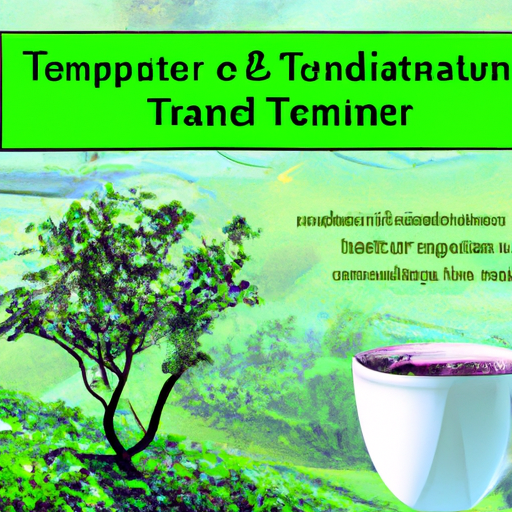Tea and Environment: Understanding the Impact of Tea Cultivation on Ecosystems and Biodiversity
As our world leans more towards eco-consciousness, there's no better time than now to steep ourselves in the world of environment and tea cultivation. You might be surprised to discover the green relationship brewing between your favorite drink and nature. It's time for us to spill the tea on the impact of tea cultivation on ecosystems and biodiversity. So, buckle up your tea cups, and let's dive right in!
Tea Cultivation and Ecosystems
Tea, as we know, comes from the leaves of the Camellia sinensis plant. The success of the tea harvest depends on favorable geographical and environmental conditions. The most ideal tea-growing regions in the world typically have a few things in common:
- High altitude
- Rich, well-drained soil
- Abundant rainfall
Tea cultivation has both positive and negative impacts on the local ecosystems. On one hand, it provides a stable and sustainable source of income for local farmers and workers. On the other hand, high-yield, monoculture tea plantations can compromise the health of the soil and biodiversity in the region.
| Pros 🌱 | Cons 🏭 |
|---|---|
| Climate-resilient | Loss of native vegetation and wildlife habitat |
| Stabilizes soil | Overuse of water resources and soil erosion |
| Carbon sequestration | Chemical pollutants from pesticides and fertilizers |
| Supports local communities | Increased vulnerability to disease and pests |
Tea Plantations and Biodiversity
In the race for productivity, the biodiversity of tea-growing regions is often overlooked. Monoculture plantations, where only tea plants are grown, tend to negatively affect the biodiversity of the region. This is because they require vast land clearances, leading to habitat fragmentation and the loss of native flora and fauna.
A Silver Lining: Bio-diverse Tea Farms
In recent years, a growing number of tea farmers and producers are embracing biodiversity within their tea-growing practices. These farms promote a harmonious relationship between tea cultivation and the surrounding ecosystems, integrating native plants and natural habitats into the tea-growing process.
Such practices assist in:
- Pest control: Reducing the need for chemical pesticides
- Nutrient cycling: Improving soil fertility and reducing the reliance on synthetic fertilizers
- Erosion control: Preventing soil loss from heavy rain and wind, thus enhancing water quality
- Providing habitats: Supporting native plant and animal species
- Enhancing ecosystem resilience: Making tea farms less vulnerable to climate change impacts and pest outbreaks
The Case of Shade-Grown Tea
Another eco-friendly approach that has been gaining popularity is the cultivation of shade-grown tea. Generally, shade-grown teas are cultivated under the canopy of taller, native trees, which serve multiple purposes:
- Reduce sunlight intensity: Shade-grown tea plants can better tolerate temperature fluctuations and climate changes
- Maintain a moisture-rich environment: The shade from trees reduces evaporation and aids water conservation
- Preserve biodiversity: The tree canopy provides a natural habitat for local wildlife and promotes a balanced ecosystem
- Tastier tea: Shade-grown teas boast a unique flavor profile, attributed to a richer concentration of nutrients and slower growth rates
Table 1: Pros and Cons of shade-grown tea
| Pros ➕ | Cons ➖ |
|---|---|
| Lower chemical input and pollution | Lower crop yields and productivity |
| Enhanced biodiversity | Longer cultivation periods |
| Unique flavor profile | Higher production costs |
| Greater tolerance to climate change | Limited consumer awareness |
What Can We Do?
As tea drinkers, it's crucial that we become more mindful of the environmental impact our tea consumption contributes. But fear not, my fellow tea enthusiasts - you don't need to sacrifice your love for tea. Instead, choose eco-conscious options and make a difference, one sip at a time:
- Opt for organic: Choose teas certified organic by credible organizations, as they are generally grown using sustainable and eco-friendly methods
- Support local and biodiverse tea farms: Encourage tea producers who actively preserve biodiversity in their tea-growing practices
- Waste not: Reduce waste by purchasing loose-leaf tea and reusable tea-bags or infusers
- Spread the word: Educate and engage in discussions with friends, family, and all tea lovers about the environmental impacts of tea cultivation
In conclusion, let's charge our teacups with a renewed appreciation for the delicate balance between tea cultivation and its environment. As we savor each sip, let's be aware tea's journey from leaf to cup, and nurture a more sustainable tea-drinking future. 💚🌍🍵
What are your thoughts on the relationship between tea and environment? Can tea be both a source of pleasure and sustainability? We'd love to hear your thoughts and ideas. Chime in below, and let's get the discussion brewing!
